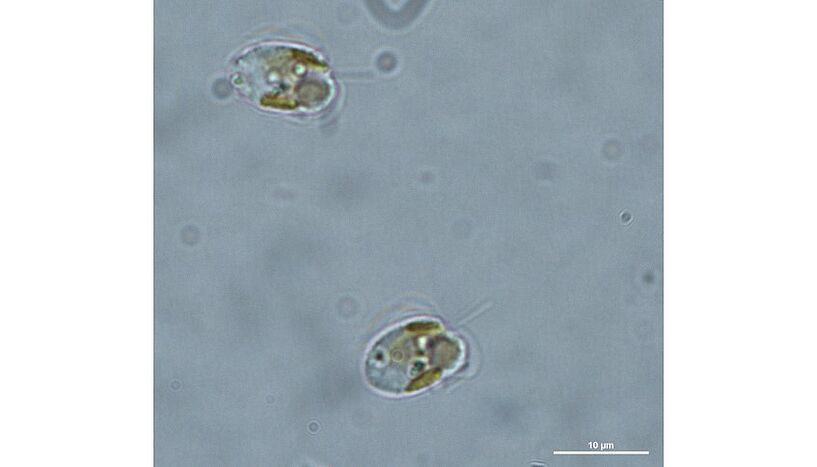Suspicion confirmed: algal toxin produced by brackish water species detected in Oder water
19. August 2022
Prymnesium parvum from the Oder near Hohenwutzen, 15.08.2022. C: Katrin Preuß, IGB
Scientists from the Leibniz Institute of Freshwater Ecology and Inland Fisheries (IGB) and the University of Vienna think that natural causes for the mass development of the algae are unlikely
The latest investigations confirm the suspicion that the mass development of a toxic brackish water alga has occurred in the Oder. This phenomenon could have played a role in the massive kill of fish, mussels, snails, and possibly other animal species. The researchers continue to believe that it is not a natural phenomenon, given that the algae species Prymnesium parvum does not, under natural conditions, occur in large numbers on the stretches of the Oder that have been hit. To occur in large numbers in this area, the species is dependent on salinity levels that can only be produced by industrial discharges. The Leibniz-Institute of Freshwater Ecology and Inland Fisheries (IGB) had detected and microscopically identified this toxic brackish water alga in all samples taken from the middle reaches of the Oder over the past few days, but the associated algal toxin had yet to be detected. Expert Elisabeth Varga from the Department of Food Chemistry and Toxicology at the University of Vienna now analysed the IGB samples and was able to confirm the assumptions about the algae toxin.
"We were able to unequivocally detect significant quantities of a subtype of the algal toxin, known as 'prymnesins', in samples taken from various parts of the Oder," stated Elisabeth Varga, a researcher from the University of Vienna who carried out the analysis at the university’s Mass Spectrometry Centre. "We know from previous research on this algal toxin that the toxin is strongly bound to the algae. When this specific algae species is present in very large quantities, as is the case in the samples from the Oder, it must also be assumed that the toxin concentration is very high. Since all of the samples were taken at an advanced stage of the algal bloom, a direct connection with the fish and mollusc kill can be assumed," explained Elisabeth Varga. However, there is still a need for further research on the toxicity of prymnesins, she added, and it has not yet been fully clarified which other groups of organisms may be affected apart from fish and molluscs. This is also true for potential effects on the human organism.
Scientists are in the process of determining the exact quantity of the toxin from the biomass samples of the alga and the water samples taken, but this procedure is more time-consuming and technically complex. "Prymnesins are very specific organic compounds, with up to 107 carbon atoms, as far as is known. Although these compounds can, in principle, be measured by advanced mass spectrometers, in practice only a few laboratories in Europe analyse them, partly because there is little need to investigate them," explained Stephanie Spahr, leader of the Organic Contaminants research group at IGB. There are no analytical standards for these toxins available anywhere in the world. For this reason, the toxins were unambiguously classified using previously characterised strains that had been cultivated at the University of Copenhagen (Per J. Hansen’s research group) and characterised at the Technical University of Denmark (Thomas O. Larsen’s research group) in the context of international projects.
"The Oder is currently suffering from an extreme mass development of planktonic algae. Prymnesium parvum is highly dominant in all samples; in the Oder, this alga accounts for at least half of the total algal biomass, and even after being diluted by the influx of the river Warta, it still stands at 36 per cent. To my knowledge, such a mass development has never been observed before in our freshwaters. The phenomenon was probably made possible by salt discharges, copious amounts of nutrients, high water temperatures, and long residence times in barrages and in the developed river," noted IGB scientist Jan Köhler, leader of the Photosynthesis and Growth of Phytoplankton and Macrophytes research group.
"Now what is missing is the genetic characterisation of the algal strain. More than 50 strains of Prymnesium parvum have been described; they differ greatly in terms of their environmental requirements and toxin production. The toxins are currently classified into three groups, with each group consisting of more than ten different toxins; this poses a significant challenge when it comes to determining them," stated Jan Köhler.
"We are now immediately contacting the competent authorities so that the research results can be integrated into new measurement campaigns and programmes," remarked IGB scientist Tobias Goldhammer, leader of the Nutrient Cycles and Chemical Analytics research group. This way, further developments on the Oder can be better monitored, he added. "The elevated salinity levels we measured in the samples occur more frequently in the Oder; they are triggered by industrial pollution in the upper reaches. Consequently, if salt levels do not decrease and we continue to experience excessively hot and dry summers, such toxic mass developments could occur again in the future," emphasised Tobias Goldhammer.
Scientific contact
DI Dr. Elisabeth Varga
Institut für Lebensmittelchemie und Toxikologie1090 - Wien, Währinger Straße 38
+43-1-4277-70811
+43-664-8176468
elisabeth.varga@univie.ac.at
Further inquiry
Theresa Bittermann, BA
Media Relations, Universität Wien1010 - Wien, Universitätsring 1
+43-1-4277-17541
theresa.bittermann@univie.ac.at
